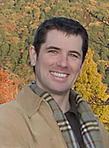Jeffrey E.F. Friedl's Blog, page 20
February 15, 2016
Kyoto Cyclocross Bicycle Race: Final Roundup
Nikon D4 + Nikkor 70-200mm f/2.8 @ 160mm — 1/1600 sec, f/3.5, ISO 250 —
map & image data — nearby photos
This should be my final post about having watched my
first cyclocross bicycle races recently.
There was a lot of mud.
Nikon D4 + Nikkor 70-200mm f/2.8 @ 140mm — 1/2000 sec, f/3.5, ISO 100 —
map & image data — nearby photos
Most photos in previous posts
(the intro,
“Practice at the Mud Baths”,
“The First Two Races”,
and “Falling in the Mud”)
concentrated on areas I called “the Mud Bath” and “Mud Hill”. I finally got far enough through my photos
to find some that show them in context a bit... here's a wider view showing folks going through
and away from the Mud Bath....
Nikon D4 + Nikkor 70-200mm f/2.8 @ 78mm — 1/1600 sec, f/2.8, ISO 160 —
map & image data — nearby photos
A reverse-angle shot from the overpass in the distance...
Nikon D4 + Nikkor 70-200mm f/2.8 @ 200mm — 1/1600 sec, f/2.8, ISO 250 —
map & image data — nearby photos
Some other random shots from the day...
Nikon D4 + Nikkor 70-200mm f/2.8 @ 200mm — 1/1600 sec, f/3.5, ISO 360 —
map & image data — nearby photos
Zig-Zag Up and Down
Nikon D4 + Nikkor 70-200mm f/2.8 @ 116mm — 1/1600 sec, f/3.5, ISO 500 —
map & image data — nearby photos
Pain
perhaps a muscle cramp
Nikon D4 + Nikkor 70-200mm f/2.8 @ 200mm — 1/1600 sec, f/3.5, ISO 560 —
map & image data — nearby photos
Dangling Chain
can't ride, but not giving up
Nikon D4 + Nikkor 70-200mm f/2.8 @ 105mm — 1/1600 sec, f/3.5, ISO 720 —
map & image data — nearby photos
Vibrant
I really like this color scheme
Nikon D4 + Nikkor 70-200mm f/2.8 @ 200mm — 1/1600 sec, f/3.5, ISO 320 —
map & image data — nearby photos
All Shapes and Sizes
Nikon D4 + Nikkor 70-200mm f/2.8 @ 80mm — 1/1600 sec, f/3.5, ISO 450 —
map & image data — nearby photos
Monochromatic
Nikon D4 + Nikkor 70-200mm f/2.8 @ 200mm — 1/1600 sec, f/3.5, ISO 360 —
map & image data — nearby photos
Wheel Dangling by the Chain
he spent considerable time trying to get his wheel reattached, but gave up
Nikon D4 + Nikkor 70-200mm f/2.8 @ 160mm — 1/1600 sec, f/2.8, ISO 400 —
map & image data — nearby photos
Unlikely Competitor
showing none of us has an excuse not to try
Nikon D4 + Nikkor 70-200mm f/2.8 @ 200mm — 1/1600 sec, f/2.8, ISO 280 —
map & image data — nearby photos
Zig-Zagging at Speed
Nikon D4 + Nikkor 70-200mm f/2.8 @ 175mm — 1/1600 sec, f/2.8, ISO 180 —
map & image data — nearby photos
Inspiring
these not-sporty-looking folks make me feel weak
for showing up with a camera instead of a bike
Nikon D4 + Nikkor 70-200mm f/2.8 @ 90mm — 1/1600 sec, f/2.8, ISO 280 —
map & image data — nearby photos
Winner
She won the CL2 (fairly advanced women's category) by more than a minute
Nikon D4 + Nikkor 70-200mm f/2.8 @ 135mm — 1/1600 sec, f/2.8, ISO 180 —
map & image data — nearby photos
Steep Uphill
Nikon D4 + Nikkor 70-200mm f/2.8 @ 150mm — 1/1600 sec, f/2.8, ISO 140 —
map & image data — nearby photos
Start'um Young
Nikon D4 + Nikkor 70-200mm f/2.8 @ 160mm — 1/1600 sec, f/2.8, ISO 320 —
map & image data — nearby photos
Nap Time
Nikon D4 + Nikkor 70-200mm f/2.8 @ 170mm — 1/1600 sec, f/2.8, ISO 220 —
map & image data — nearby photos
Weary Competitors
just before the final turn toward the finish
Nikon D4 + Nikkor 70-200mm f/2.8 @ 200mm — 1/1600 sec, f/2.8, ISO 110 —
map & image data — nearby photos
Back Stretch
Nikon D4 + Nikkor 70-200mm f/2.8 @ 200mm — 1/1600 sec, f/2.8, ISO 110 —
map & image data — nearby photos
All in the Family?
they seemed to ride together
The young girl in the photo above is not riding in any of the kids' categories... she's in “Ladies Category 3”, which means she's good
enough to have earned the right to move on from the any-female-can-enter “Ladies 4”. The winner of the next step up, “Ladies 2”,
seen above in “Winner”, has the same family name and team affiliation... perhaps a sister or a cousin.
Nikon D4 + Nikkor 70-200mm f/2.8 @ 200mm — 1/1600 sec, f/2.8, ISO 320 —
map & image data — nearby photos
Fighting Spirit
Riko Okabe, an acquaintance seen in my last post of 2015
She went on to place 4th in her “Ladies 3” race
Nikon D4 + Nikkor 70-200mm f/2.8 @ 200mm — 1/1600 sec, f/2.8, ISO 280 —
map & image data — nearby photos
More Inspiration
Nikon D4 + Nikkor 70-200mm f/2.8 @ 190mm — 1/1600 sec, f/3.2, ISO 250 —
map & image data — nearby photos
Riko Okabe
Nikon D4 + Nikkor 70-200mm f/2.8 @ 170mm — 1/1600 sec, f/3.2, ISO 800 —
map & image data — nearby photos
Weary Moment's Rest
Nikon D4 + Nikkor 70-200mm f/2.8 @ 140mm — 1/1600 sec, f/2.8, ISO 250 —
map & image data — nearby photos
“Kids 2” Start
one boy jumps off to a quick lead
Nikon D4 + Nikkor 70-200mm f/2.8 @ 86mm — 1/1600 sec, f/2.8, ISO 450 —
map & image data — nearby photos
Form
the bike seems a bit big at first glance,
but he won by almost a minute, so I guess he's doing something right
Nikon D4 + Nikkor 70-200mm f/2.8 @ 140mm — 1/1600 sec, f/2.8, ISO 360 —
map & image data — nearby photos
Warmup
for a later race
Nikon D4 + Nikkor 70-200mm f/2.8 @ 150mm — 1/1600 sec, f/2.8, ISO 400 —
map & image data — nearby photos
Vincent Arrives
Vincent Flanagan, seen on my blog in my writeup of his PedalForth Fitting
bike-fitting service and in various ride reports, such as this fall group
ride, is a former Australian National Mountain Bike Champion (1991), and a
two-time All-Japan National Mountain Bike Champion (1996, 1997), so he's no stranger to racing. His “Masters 1” race (highest-tier race for men 40 and
over) wasn't until long after I had to leave, so I've no photos, but I can report that he finished in
the top third, which is all the more impressive since he's got a decade or two on some of the
competitors.
February 13, 2016
Snowy Frigid Ohio Morning
Nikon D4 + Nikkor 24-70mm f/2.8 @ 38mm — 1/125 sec, f/7.1, ISO 6400 —
map & image data — nearby photos
Sunrise at 5°F
-15°C — Rootstown, Ohio, USA
It's pretty chilly this morning here in Ohio, about 5°F (−15°C), with about 8" (20cm) of recent snow. It's not all that bad by Ohio standards, but it's been 30 years since I lived here, and Kyoto rarely gets
much below freezing. Then again, it was only two years ago that I visited Ohio when
it was -10°F (-23°C), so I guess today isn't so bad.
I woke up with the light, and it looked so pretty and calm outside that I had to run out with the camera. I only have one lens with me on this trip, a Nikkor 24-70/2.8.
Nikon D4 + Nikkor 24-70mm f/2.8 @ 24mm — 1/100 sec, f/2.8, ISO 1000 —
map & image data — nearby photos
Risky
taking a shot from under the snow-laden branches
Nikon D4 + Nikkor 24-70mm f/2.8 @ 24mm — 1/100 sec, f/2.8, ISO 1400 —
map & image data — nearby photos
Warm
though I was hoping for more orange spill from the incandescent lighting inside
Nikon D4 + Nikkor 24-70mm f/2.8 @ 70mm — 1/320 sec, f/2.8, ISO 2000 —
map & image data — nearby photos
Nasty Roads
the reason I have time this morning, instead of heading in to the hospital to visit Mom
Nikon D4 + Nikkor 24-70mm f/2.8 @ 31mm — 1/125 sec, f/2.8, ISO 720 —
map & image data — nearby photos
49½ Years
how long that sign has been up
Nikon D4 + Nikkor 24-70mm f/2.8 @ 70mm — 1/320 sec, f/2.8, ISO 800 —
map & image data — nearby photos
Downy Woodpecker
I fed the birds outside — they've trained us well,
as seen
here
and
here —
and tried a few pictures. Lack of lenses, warmth, and skill limited the results.
Nikon D4 + Nikkor 24-70mm f/2.8 @ 70mm — 1/320 sec, f/2.8, ISO 250 —
map & image data — nearby photos
Bluebirds
Nikon D4 + Nikkor 24-70mm f/2.8 @ 70mm — 1/320 sec, f/2.8, ISO 180 —
map & image data — nearby photos
There were goldfinches, bluebirds, chickadees, red-bellied woodpeckers, downy woodpeckers, doves,
bluejays, and I think some other kind of finches and birds I wasn't sure about.
Bird photography is difficult and I'm no good at it, though I have gotten some lucky shots
before:
Freezing Bird Movement with a Fast Shutter (and Arctic Temperatures)
Goldfinches in a Light Snow
Impromptu Chickadee Portraiture
My Morning: Birds, Flowers, Coffee, and my Camera
Can’t Get Any Work Done With Birds on my Laptop
The most recent “What the Duck”, Aaron Johnson's photography-centric comic, is perfectly appropriate:
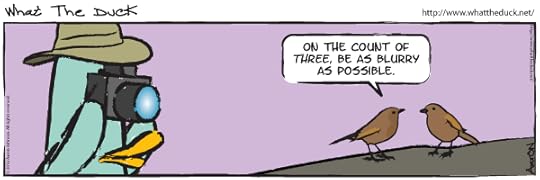
The sun eventually came out, with a beautiful blue sky (that gets washed out in these pics)...
Nikon D4 + Nikkor 24-70mm f/2.8 @ 29mm — 1/2500 sec, f/2.8, ISO 100 —
map & image data — nearby photos
Nikon D4 + Nikkor 24-70mm f/2.8 @ 26mm — 1/800 sec, f/2.8, ISO 100 —
map & image data — nearby photos
Still Risky
Nikon D4 + Nikkor 24-70mm f/2.8 @ 36mm — 1/160 sec, f/11, ISO 200 —
map & image data — nearby photos
Finishing a Lap
In the past we've seen
“Jogging with Grandpa” (7½ years ago)
and “Jogging with Grandpa, 2010 Edition” (5½ years ago),
and my 84-year-old dad still runs almost every day.
Nikon D4 + Nikkor 24-70mm f/2.8 @ 34mm — 1/500 sec, f/2.8, ISO 100 —
map & image data — nearby photos
Laughing
at the thought I'd want to take his photo
With the sun out, I tried a few more bird pictures...
Nikon D4 + Nikkor 24-70mm f/2.8 @ 70mm — 1/1600 sec, f/2.8, ISO 100 —
map & image data — nearby photos
Stacked Bluebirds
Nikon D4 + Nikkor 24-70mm f/2.8 @ 70mm — 1/500 sec, f/2.8, ISO 100 —
map & image data — nearby photos
Worm Acquisition
Nikon D4 + Nikkor 24-70mm f/2.8 @ 70mm — 1/800 sec, f/2.8, ISO 100 —
map & image data — nearby photos
Absconding with the Loot
February 6, 2016
Falling in the Mud: A Cyclocratic Medaphore for Life
Nikon D4 + Nikkor 70-200mm f/2.8 @ 102mm — 1/1600 sec, f/3.5, ISO 450 —
map & image data — nearby photos
Déjà Vu
織田 智陽さん
Last week's “Watching My First
Cyclocross Bike Race” opened with the photo above. Today I'll share the whole fun sequence of
photos that followed.
Nikon D4 + Nikkor 70-200mm f/2.8 @ 102mm — 1/1600 sec, f/3.5, ISO 450 —
map & image data — nearby photos
T + 0.2 seconds
Nikon D4 + Nikkor 70-200mm f/2.8 @ 90mm — 1/1600 sec, f/3.5, ISO 360 —
map & image data — nearby photos
T + 0.6 seconds
Nikon D4 + Nikkor 70-200mm f/2.8 @ 82mm — 1/1600 sec, f/3.5, ISO 320 —
map & image data — nearby photos
T + 1.1 seconds
Nikon D4 + Nikkor 70-200mm f/2.8 @ 82mm — 1/1600 sec, f/3.5, ISO 360 —
map & image data — nearby photos
T + 2.4 seconds
Nikon D4 + Nikkor 70-200mm f/2.8 @ 82mm — 1/1600 sec, f/3.5, ISO 450 —
map & image data — nearby photos
T + 5.0 seconds
Nikon D4 + Nikkor 70-200mm f/2.8 @ 70mm — 1/1600 sec, f/3.5, ISO 720 —
map & image data — nearby photos
T + 9.9 seconds
Nikon D4 + Nikkor 70-200mm f/2.8 @ 70mm — 1/1600 sec, f/3.5, ISO 180 —
map & image data — nearby photos
T + 12.2 seconds
As I write this I'm dealing with a family medical emergency in America, and as I
sit in a hospital waiting room, these photos from a cyclocross bicycle
race last week in Kyoto Japan strike me as a perfect metaphor for life: if you suffer a setback, just shake it off, put on a smile, and continue forward.
(PS: I just made up the “Cyclocratic” seen in the title; there's probably a more grammatically-appropriate word I could have made up.)
February 5, 2016
Muddy Kyoto Cylocross: The First Two Races
Nikon D4 + Nikkor 70-200mm f/2.8 @ 70mm — 1/1600 sec, f/2.8, ISO 800 —
map & image data — nearby photos
Skill and Concentration
Taijo Hino (日野 泰静)
This post, brought to you at 4am by jetlag, is a continuation from “Cyclocross Races: Practice at the Mud Bath”. Above we have the very
first rider of the first race to make it to where I was at the Mud Bath.
The first race actually was
three separate races run in parallel: “Category 3” (men who had earned the right to advance from the anyone-can-enter Category
4), “Masters 2” (men 40 and over who
have done well enough to progress from Masters 3 and Masters 4), and “U17”, children 17 and under who, presumably, are too old or too skilled for “U15”.
The boy above, presumably 16 or 17 years old, so totally dominated the course that the next finisher, from any of the
three races, didn't come in until a minute and a half later. My friend Andy, who ran a strong race coming in 8th of 54 in Category
3, didn't finish until more than three minutes after the boy above.
The boy had won bronze in the Japanese National Road Race Championships last year, so I guess this short cyclocross race isn't such a challenge. 
It's cute to see his twitter page, which has been
inactive since 2012. The tweets then, presumably as a middle-school kid, include things like
“School starts tomorrow! Winter break tooooooo short”
and “Crepes were tasty today”, but also stuff like “Today's mountain-bike practice was
tough, but I do it for myself”.
Nikon D4 + Nikkor 14-24mm f/2.8 @ 24mm — 1/1600 sec, f/13, ISO 2200 —
map & image data — nearby photos
Andy's Second Trip Through the Mud Bath
Nikon D4 + Nikkor 14-24mm f/2.8 @ 14mm — 1/1600 sec, f/2.8, ISO 125 —
map & image data — nearby photos
Reverse Angle
the mud trail at left leads away from the Mud Bath
As I described in the initial post, the course progresses away from
the Mud Bath, then does a 180 and returns back (along the line of cars seen in the background of the picture above), then
another 180 away, and finally another 180 to return towards the area next to the Mud Bath. That's where the four riders are in the shot above.
As they pass beside the Mud Bath, they have to climb a somewhat-less-muddy, but decidedly-more-hilly section.
I'll call it the “Mud Hill”.
Nikon D4 + Nikkor 24-70mm f/2.8 @ 62mm — 1/1600 sec, f/2.8, ISO 360 —
map & image data — nearby photos
Antti Approaching the Mud Hill
Nikon D4 + Nikkor 70-200mm f/2.8 @ 86mm — 1/1600 sec, f/2.8, ISO 1000 —
map & image data — nearby photos
Bogged Down on Mud Hill
Nikon D4 + Nikkor 24-70mm f/2.8 @ 58mm — 1/1600 sec, f/2.8, ISO 450 —
map & image data — nearby photos
Andy's Third Trip Through the Mud Bath
for the final lap, Andy tried riding through, and succeeded
The second race of the day involved two categories running in parallel, “C4” (Category 4, open to any man with the entry fee)
and “CM3” (Masters 3, men 40 and above who earned promotion from “CM4”). German friend Christoph Millotat was racing in C4.
Nikon D4 + Nikkor 70-200mm f/2.8 @ 75mm — 1/1600 sec, f/2.8, ISO 500 —
map & image data — nearby photos
Christoph
Nikon D4 + Nikkor 70-200mm f/2.8 @ 200mm — 1/1600 sec, f/2.8, ISO 360 —
map & image data — nearby photos
Not Christoph
Nikon D4 + Nikkor 70-200mm f/2.8 @ 200mm — 1/1600 sec, f/2.8, ISO 560 —
map & image data — nearby photos
Christoph
Nikon D4 + Nikkor 70-200mm f/2.8 @ 125mm — 1/1600 sec, f/2.8, ISO 500 —
map & image data — nearby photos
At One of the Aforementioned 180° Turns
Nikon D4 + Nikkor 14-24mm f/2.8 @ 14mm — 1/1600 sec, f/14, ISO 3600 —
map & image data — nearby photos
Mud Hill Again
Nikon D4 + Nikkor 14-24mm f/2.8 @ 14mm — 1/1600 sec, f/14, ISO 2000 —
map & image data — nearby photos
Straddling Into No-Man's Land
between mud hill on the left and the mud bath on the right
Nikon D4 + Nikkor 14-24mm f/2.8 @ 14mm — 1/1600 sec, f/10, ISO 1800 —
map & image data — nearby photos
The “Not Christoph” Guy From Above
approaching the mud bath for the 2nd time
Nikon D4 + Nikkor 14-24mm f/2.8 @ 14mm — 1/1600 sec, f/10, ISO 2000 —
map & image data — nearby photos
Nope
The guy's aggression did pay off, though; he came in 4th in his race.
Nikon D4 + Nikkor 14-24mm f/2.8 @ 14mm — 1/1600 sec, f/10, ISO 3200 —
map & image data — nearby photos
Christoph Approaching Mud Hill
Nikon D4 + Nikkor 70-200mm f/2.8 @ 130mm — 1/1600 sec, f/8, ISO 900 —
map & image data — nearby photos
“The Competitor”
The guy seen here moves slowly but surely through the mud bath.
He did not stop or fall.
Nikon D4 + Nikkor 70-200mm f/2.8 @ 102mm — 1/1600 sec, f/8, ISO 1800 —
map & image data — nearby photos
Christoph's Final Trip
through the mud bath
To be continued...
February 2, 2016
Cyclocross Races: Practice at the Mud Bath
Nikon D4 + Nikkor 70-200mm f/2.8 @ 150mm — 1/640 sec, f/2.8, ISO 400 —
map & image data — nearby photos
Sometimes You've Just Got To Say...
(whatever you say when you decide to ignore the drabacks and forge ahead)
I'm currently at airport hotel in Osaka (which I've recommended before)
so I can make an early flight out in the morning, for an unfortunately-sudden family-emergency trip to America.
Having arrived here with plenty of time, I'll go ahead follow up on this weekend's
“Watching My First Cyclocross Bike Race”.
Today's pictures concentrate on the Mud Bath during the practice before the races.
Nikon D4 + Nikkor 70-200mm f/2.8 @ 130mm — 1/640 sec, f/2.8, ISO 280 —
map & image data — nearby photos
It's Difficult to Tell
where the mud stops and the bike starts
Nikon D4 + Nikkor 70-200mm f/2.8 @ 98mm — 1/640 sec, f/2.8, ISO 100 —
map & image data — nearby photos
Ridiculously Thick
Nikon D4 + Nikkor 24-70mm f/2.8 @ 48mm — 1/400 sec, f/2.8, ISO 100 —
map & image data — nearby photos
The Most-Common Outcome
Nikon D4 + Nikkor 70-200mm f/2.8 @ 70mm — 1/400 sec, f/2.8, ISO 100 —
map & image data — nearby photos
Giving Up Before They Start
or, perhaps “saving it for the race”
Nikon D4 + Nikkor 70-200mm f/2.8 @ 110mm — 1/640 sec, f/2.8, ISO 100 —
map & image data — nearby photos
Successful Technique
A common pattern was for the rider to enter fast and powerful, with the apparent intention to just brute force his way through
the mud. This would have been fine except that the mud was sufficiently deep to grab the front wheel, flipping the bike up enough
so that the back wheel no longer had traction. Forward momentum immediately stopped, and the rider who couldn't unclip in time
found himself lying in the mud.
The rider above puts his weight as far back as possible, putting some weight behind the bike so that it helps shove the bike
through the mud, and also more weight in the rear helps to keep the back wheel in play. Riders that entered this way usually did
better.
Nikon D4 + Nikkor 24-70mm f/2.8 @ 50mm — 1/1600 sec, f/2.8, ISO 400 —
map & image data — nearby photos
Muddy Grace
having just picked herself up from the mud, she has the poise to flash a wonderful smile
Nikon D4 + Nikkor 24-70mm f/2.8 @ 70mm — 1/320 sec, f/2.8, ISO 110 —
map & image data — nearby photos
Up To His Feet in Mud
the mud is so thick his pedaling foot is in it
Nikon D4 + Nikkor 70-200mm f/2.8 @ 200mm — 1/1600 sec, f/2.8, ISO 1600 —
map & image data — nearby photos
Beyond His Feet in Mud
one can only presume there's a foot in there somewhere
Nikon D4 + Nikkor 14-24mm f/2.8 @ 14mm — 1/400 sec, f/10, ISO 3200 —
map & image data — nearby photos
Final Rest
before the races start
To be continued...
February 1, 2016
New Lightroom Plugin: “Bag-o-Goodies” Collection of Tools
I've just released a new plugin for Adobe Lightroom called
Bag-o-Goodies. It's a (currently small) collection
of little tools that don't merit their own plugin.
One tool lets you compare the shot-taken time between two pictures, such as these
shots from yesterday's Kansai Cyclocross races...
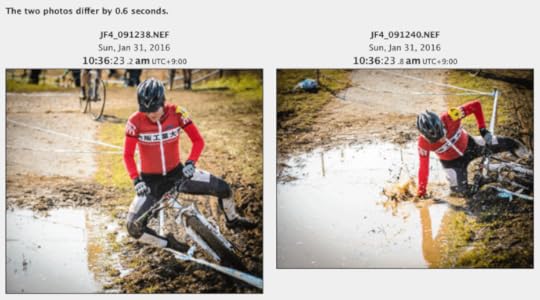
Slow Motion
I bet it felt a lot longer than 6/10th of a second
... or this set showing the gap between Andy and Antti when they passed me on their final lap...
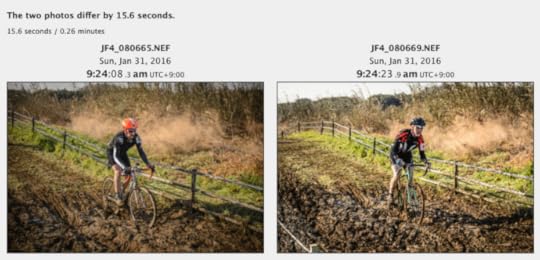
... or this set of first-shots from my first “real” camera (a Nikon D200) and my current “real” camera
(a Nikon D4)....
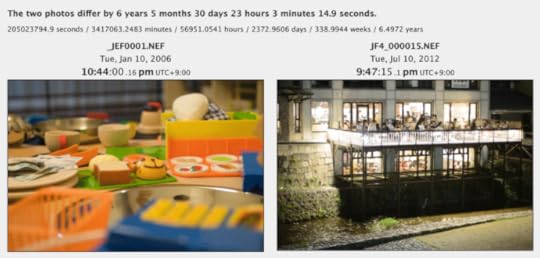
Anyway, there are only three little tools now, but now that I have the mechanism in place to add them, I hope to expand it little by little over time.
It's available over on the Bag-o-Goodies plugin page.
January 31, 2016
Watching My First Cyclocross Bike Race
Nikon D4 + Nikkor 70-200mm f/2.8 @ 102mm — 1/1600 sec, f/3.5, ISO 450 —
map & image data — nearby photos
This Will Not End Well
(for him, that is. For me, it was great
 )
)Today was the last race of the local cyclocross-racing season, and I took the
opportunity to see some friends race. Cyclocross bicycle racing is sort of like mini-obstacle-course bicycle racing, with a few
laps on a relatively short course going over steep embankments, through mud and sand, over barriers, etc. It rained quit a bit a
few days ago, so the course had plenty of photogenic mud.
I literally have not yet seen all the photos I took, but I wanted share a few so as to share the gist of the day.
There are races throughout the day for various categories, but I arrived before the first to check out the course. The cyclists were doing the same. I found one particularly-interesting area...
Nikon D4 + Nikkor 70-200mm f/2.8 @ 125mm — 1/500 sec, f/2.8, ISO 180 —
map & image data — nearby photos
Mud Bath
The mud was deceptively deep, so if you didn't see someone in it as in the photo above, it was easy to
misjudge your entry and find yourself involuntarily off the bike....
Nikon D4 + Nikkor 70-200mm f/2.8 @ 78mm — 1/400 sec, f/2.8, ISO 100 —
map & image data — nearby photos
... And This is Just a Practice Lap
A cyclocross lap generally includes sections where you must get off the bike and carry it over obstacles, but also many
sections like the Mud Bath above where you can try to ride or just push/carry the bike if you think it'll be faster. Most folks
chose the latter.
This included American friend Andy Clark, who was near the front in the first race,
the Men's “C3” (“Category 3”) race....
Nikon D4 + Nikkor 70-200mm f/2.8 @ 200mm — 1/1600 sec, f/2.8, ISO 640 —
map & image data — nearby photos
Charging Toward the Mud Bath
Andy started this season (his first) in Category 4, which is open to all who have a bike, the entry fee, and a free Sunday. But one gets elevated to Category 3 only by earning it, which he did quickly earlier in the season.
Andy's been on my blog numerous times since I started cycling, including
here,
here, and
here.
In cyclocross it's very good to be in front of the pack, because otherwise you can get bogged down in
a clump of competitors...
Nikon D4 + Nikkor 70-200mm f/2.8 @ 86mm — 1/1600 sec, f/2.8, ISO 720 —
map & image data — nearby photos
The Scrum Arrives
Nikon D4 + Nikkor 70-200mm f/2.8 @ 200mm — 1/1600 sec, f/2.8, ISO 1400 —
map & image data — nearby photos
Glorious
After passing the Mud Bath, the course continued away, and after three 180° hairpins across various parts of an embankment,
the course came back past me on the other side, up a different hill that was sufficiently-less muddy to entice more
folks to try actually riding up it.
Nikon D4 + Nikkor 14-24mm f/2.8 @ 16mm — 1/1600 sec, f/13, ISO 3200 —
map & image data — nearby photos
Andy Charges Ahead
Nikon D4 + Nikkor 70-200mm f/2.8 @ 80mm — 1/1600 sec, f/2.8, ISO 320 —
map & image data — nearby photos
Not Always Smooth Sailing
Nikon D4 + Nikkor 70-200mm f/2.8 @ 155mm — 1/1600 sec, f/3.2, ISO 560 —
map & image data — nearby photos
Easier to Carry
Nikon D4 + Nikkor 24-70mm f/2.8 @ 24mm — 1/1600 sec, f/2.8, ISO 450 —
map & image data — nearby photos
Forgot To Tie His Shoe?
Nikon D4 + Nikkor 24-70mm f/2.8 @ 44mm — 1/1600 sec, f/2.8, ISO 400 —
map & image data — nearby photos
Antti Rides the Mud Bath
Finnish friend Antti was also in the “C3” race. He got caught behind a big pileup near the start, so was trying to claw back time. He successfully rode through the Mud Bath.
You might recall Antti from this post about how well he
took care of things when a friend crashed on a group ride. He was also with my on
my first ride to the ocean, among many others, including
my very first ride.
Nikon D4 + Nikkor 24-70mm f/2.8 @ 70mm — 1/1600 sec, f/2.8, ISO 320 —
map & image data — nearby photos
The Mud Bath made for fun (for me), but it didn't usually give photos of people actually riding bicycles,
and when I turned around to get folks coming back the other way, the background (the parking lot) was horrible.
With the photo above, I tried to lessen the impact of the background with some creative processing.
Back to the mud-bath fun...
Nikon D4 + Nikkor 70-200mm f/2.8 @ 110mm — 1/1600 sec, f/2.8, ISO 280 —
map & image data — nearby photos
Bumper Cars
Nikon D4 + Nikkor 70-200mm f/2.8 @ 130mm — 1/1600 sec, f/2.8, ISO 250 —
map & image data — nearby photos
True Grit
Nikon D4 + Nikkor 70-200mm f/2.8 @ 200mm — 1/1600 sec, f/3.2, ISO 200 —
map & image data — nearby photos
Mud, Literally and Literately
the character on the back of his jersey means “mud”
In their C3 race, which was three laps of the course, Andy ended up getting 8th out of 54. Antti got 11th. Very good.
German friend Christoph Millotat rode in the C4 race...
Nikon D4 + Nikkor 70-200mm f/2.8 @ 75mm — 1/1600 sec, f/2.8, ISO 640 —
map & image data — nearby photos
Christoph Traversing the Mud Bath
Nikon D4 + Nikkor 70-200mm f/2.8 @ 150mm — 1/1600 sec, f/2.8, ISO 900 —
map & image data — nearby photos
Nikon D4 + Nikkor 70-200mm f/2.8 @ 70mm — 1/1600 sec, f/2.8, ISO 400 —
map & image data — nearby photos
Checking the Mud
yup, still muddy
The mud was very soupy in the morning, but as riders took its moisture away on them (and their clothes and bikes), the mud
got a bit firmer as the day went. But it was still mud.
Nikon D4 + Nikkor 14-24mm f/2.8 @ 14mm — 1/1600 sec, f/10, ISO 1600 —
map & image data — nearby photos
As I said, there are many categories, including various levels for women. The ladies got in the mud just like the guys...
Nikon D4 + Nikkor 70-200mm f/2.8 @ 125mm — 1/1600 sec, f/3.5, ISO 220 —
map & image data — nearby photos
In One Sense
“In the mud like the guys” in one sense
Nikon D4 + Nikkor 70-200mm f/2.8 @ 82mm — 1/1600 sec, f/3.5, ISO 450 —
map & image data — nearby photos
And In Another
“In the mud like the guys” in another sense
Nikon D4 + Nikkor 70-200mm f/2.8 @ 200mm — 1/1600 sec, f/2.8, ISO 280 —
map & image data — nearby photos
Kids Too
Because I was camped out at the Mud Bath, my photos haven't shown much else of the course, but here's one that gives
more of an idea of some of the nastier parts...
Nikon D4 + Nikkor 70-200mm f/2.8 @ 200mm — 1/1600 sec, f/8, ISO 1000 —
map & image data — nearby photos
Zig-Zaggy Up and Down
The guy in the center of that photo illustrates a great thing about amateur cyclocross racing...
Nikon D4 + Nikkor 70-200mm f/2.8 @ 200mm — 1/1600 sec, f/8, ISO 1600 —
map & image data — nearby photos
Competitor
The easy categories are open to everyone and they're probably the safest kind of competitive cycling, as speeds are never very
fast. One can spend a lot on a bike, but it's not
required, so the real barrier to entry is mental. The guy above is obviously out of shape, but he's out
there doing it, giving it a try, not giving up. He certainly got a better workout than I did just standing around all day.
And what happens when an out of shape guy like that intrudes on the world of the fit cyclist? He gets
cheered on and encouraged...
Nikon D4 + Nikkor 24-70mm f/2.8 @ 48mm — 1/1600 sec, f/2.8, ISO 450 —
map & image data — nearby photos
Andy Cheers the Competitor On
with words of encouragement and a noisy cowbell
Nikon D4 + Nikkor 70-200mm f/2.8 @ 140mm — 1/1600 sec, f/3.5, ISO 280 —
map & image data — nearby photos
To be continued...
January 19, 2016
More Details on the Insidious iOS Snap-to-Road “Feature”
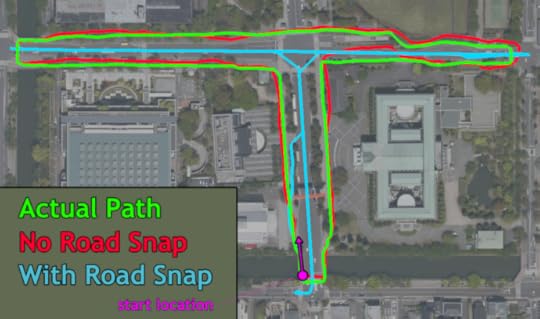
More iPhone Location-Track Testing
This post is a short followup to last month's “The Scourge (or
Beauty) of “Snap To Road” with iPhone Location-Tracking Apps”, in which I explained how an attempt by Apple to make the iPhone
location services more relevant for car navigation can end up destroying the accuracy for other uses such as geoencoding or
fitness tracking. When enabled, the user's location is “snapped” to the center of the nearest road; internally Apple calls
it “Map Matching”; I call it “Snap to Road”.
In the screenshot of Google Earth seen above, the red line, recorded with the “Snap to Road” feature disabled, mostly matches up with my green-line actual path (which I drew on the map by hand from
memory), but the cyan line, recorded with “Snap to Road” enabled, is
ridiculously devoid of detail... it makes it appear as if I was walking down the exact center of each
road; you can't see what side of the road I was on, nor even that there are turns at the edges.
Unfortunately, this iOS feature can not simply be enabled or disabled by the user or the app developer — Apple, in its
infinite wisdom, chooses when it goes on and off and does not share any details (or even confirm that it happens!) — so
I wanted to do more testing to understand when it does or doesn't become enabled.
Evgen Bodunov, the developer of the most-excellent
Galileo Offline Maps, kindly made a special version of his app
for me which allowed me to explicitly choose the iOS CoreLocation service
“Activity Type”.
I did a bunch of riding around with the phone set to
various situations, and came up with a few more details...
ul#snaplist li { margin-bottom: 30px }
“Snap to Road” is tripped on when you exceed 20kph (12mph).
In the screenshot, notice how the cyan line matches the actual track near the start of the ride, then halfway up the “T” it snaps
to the center of the road. That's when my speed crested 20kph after riding slowly from the starting point.
I'm not sure under what conditions it turns back off; merely slowing down to below that threshold is not sufficient to turn it
back off, as I could continue at a walking pace for several minutes and it would not turn off.
In some tests merely pausing or changing direction turned it off, but in other tests seemingly-similar actions did not turn it
off. This remains a mystery.
iOS seems to require Internet access (or cached map data) for it to work.
I disconnected my phone from the Internet (turned on airplane mode and turned off WiFi) and rebooted
the phone, and I could not get the “Snap to Road” to kick in, even at fairly high speeds.
However, upon exiting airplane mode, “Snap to Road” kicked in the next time I exceeded 20kph.
The “OtherNavigation” activity type is the only CoreLocation activity type that does not
invite “Snap to Road” on its own.
This is a confirmation of what I reported previously, that even at high speeds, “Snap to Road” remain thankfully disabled
with OtherNavigation. The other three
activity types all get “Snap to Road” at 20kph.
(However, there's still the caveat that if any app triggers “Snap to Road”, all apps get “Snap to Road”.)
As expected, I've not heard any reply from Apple on the bug report I submitted.
January 10, 2016
Great Excitement in Small Pleasures: A Starbucks Opens Nearby
Panasonic LX100 at an effective 24mm — 1/125 sec, f/1.7, ISO 1600 —
map & image data — nearby photos
ROHM Theater Kyoto
ロームシアター京都
The old Kyoto Theater Hall near my house reopened today after some years of renovation,
emerging as “ROHM Theater Kyoto”
(ロームシアター京都).
ROHM is a semiconductor company based here in Kyoto, last mentioned on my blog more than 10 years ago,
before I got into photography or even blogging that much, on this post
about their annual Christmas lights at their company headquarters. They must have paid a boatload of money to someone
to get branding rights for this renovated concert/theater complex.
I have a vague recollection of seeing some kind of performance at the original theater 25 years ago,
when trekking this deep into Kyoto was a rare thing for me.
(I lived in Takatsuki City at the time).
More recently, the old hall was the site of the Presidential visit seen 10 years ago in
“Presidential Visit means REALLY BIG hubbub”,
and since we live nearby, it's been in the background of numerous shots, such as this
and this
and this
and this
and this.
Anyway, we don't really care about the theater itself, but the BIG BIG BIG excitement of the reopening is that it now
includes a combined TSUTAYA Bookstore + Starbucks Coffee!!!!!!!!!!!!!!!
Panasonic LX100 at an effective 24mm — 1/125 sec, f/7.1, ISO 2500 —
map & image data — nearby photos
The theater had grand-opening events all day, but we were interested only in the 4:30pm grand opening of the Starbucks.
We didn't know whether thousands might be waiting in line or no one, but we wanted to check things out so we headed over there a bit before.
It was bustling but not crazy. We showed up to find that they had taken pity on all those waiting in line and opened early, so
the line was moving along briskly by the time we entered, and the wait was 20 minutes.
Panasonic LX100 at an effective 24mm — 1/40 sec, f/7.1, ISO 1600 —
map & image data — nearby photos
Kyoto Starbucks Coffee Cup
Panasonic LX100 at an effective 24mm — 1/80 sec, f/4.5, ISO 3200 —
map & image data — nearby photos
10 Staff
where presumably two or three would normally be

Panasonic LX100 at an effective 24mm — 1/30 sec, f/5.6, ISO 3200 —
map & image data — nearby photos
Our Order
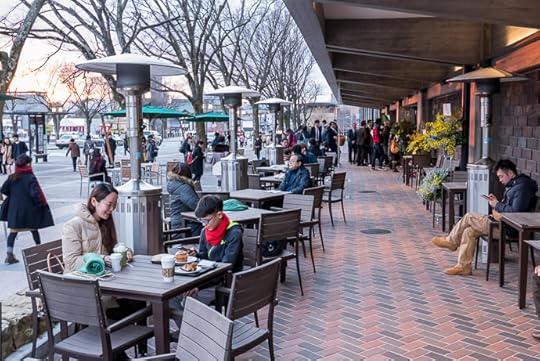
Panasonic LX100 at an effective 40mm — 1/50 sec, f/5.6, ISO 1600 —
map & image data — nearby photos
We Sat
away from the hubbub and it was quiet and nice
Panasonic LX100 at an effective 24mm — 1/20 sec, f/5.6, ISO 3200 —
map & image data — nearby photos
Second Floor Restaurant & Bar
not part of Starbucks, but somehow integrated
Panasonic LX100 at an effective 38mm — 1/30 sec, f/5, ISO 1600 —
map & image data — nearby photos
Restaurant's Menu
on the pricey side
Panasonic LX100 at an effective 24mm — 1/125 sec, f/2, ISO 1250 —
map & image data — nearby photos
Third Floor
some kind of lounge / book area
I guess you can bring your Starbucks order here to chill
We like Starbucks coffee and even if it were a normal Starbucks we'd be pleased that it's close
(but not within sight 
January 5, 2016
Lightroom Resource Utilization: On Setting Up a Machine for Lightroom Usage
Panasonic LX100 at an effective 43mm — 1/1250 sec, f/3.5, ISO 200 —
map & image data — nearby photos
Desktop-Background Versions
1280×800 · 1680×1050 · 1920×1200 · 2560×1600 · 2880×1800
Adobe Lightroom deals with a lot of data — sometimes thousands of images at a time, each
one potentially huge by itself — so it uses a lot of computer resources. When setting up a machine for Lightroom use, one wants to know what kinds of upgrades will be most effective, and along these
lines I got an email from James Palik, a professional photographer who also
teaches processing and workflow with Lightroom, asking specific questions about Lightroom resource management.
Sadly I'm not the right person to ask about this kind of stuff, but luckily I have a contact within Adobe who is. I've
received permission to reproduce the questions and answers here so that all my benefit.
The current version of Lightroom is 6.3 (LrCC 2015.3).
table.q2664 { margin-top:30px}
table.q2664 tr { vertical-align: baseline }
table.q2664 tr:first-child td { font-weight:bold }
Q:How much installed memory will Lightroom address. For example, is there any
value to installing a full 64 GB on a Windows machine.
A:
Lightroom 6 runs as a native 64-bit application. In theory, the
image processing engine can use up to 50% of the total RAM on your system
to backup its internal virtual memory system. Typically, processing a
single photo would not require 32GB of RAM. Current Lightroom
heuristics set a maximum limit on the number of negatives cached in RAM
at any given time (last 3 or 4 negatives loaded). So having more RAM
adding to the machine would not be helpful.
However, if you could use the
additional RAM to setup as RAM disk. That would be immensely helpful to
speedup the previously loaded negatives. This is the same reasoning why
having the catalog and negatives (Smart Previews) on a fast SSD drive is
very helpful.
In the normal case, I would currently recommend 16GB of RAM.
Q:Lightroom determines a set amount of Cache when it is installed. How does Lightroom determine this setting?
A:
I assume by “Cache” you meant the camera raw cache? It depends on
your workflow. If you are following a DNG-only workflow with “Fast Load
Data” embedded, the camera raw cache rarely comes into play. If you process the raw files (CR2, NEF, RAF) only, then having a bigger camera
raw cache is very helpful. It depends on the number of photos that you
would need to process through each time and how often that you need to go
back and reprocess them. Having the camera raw cache directory on a faster
drive is very beneficial.
Q:When does Lightroom start to use Cache. (in what part of the
development process)
A:
Every time that Lightroom would need to render the negatives with
the adjustment settings, in the develop module or the quick develop in the
library module.
Q:
When it comes to CPUs and cores, what is your best advice for purchasing the most powerful
standalone machine when it is going to be used almost exclusively
for photography processing in Lightroom?
A:
Lightroom likes multiple processors/mult-cores and make uses of
them.
Q:Will Lightroom take advantage of dual processors?
A:
Yes.
Q:How many cores will Lightroom take advantage of?
A:
Since Lr 6.2, Lightroom will make use of all cores available.
In
all Lightroom versions, you can check the Lightroom's System Info dialog
invoked from the Help menu. It has a field named “Maximum thread count
used by Camera Raw” that tells how many cores that Lightroom will be using.
There we have it. Some of the answers bring up further questions, but hopefully this information
will be of value. The RAM disk for the Camera Raw cache seems like an easy place to win greatly,
if you have the spare memory. The size and location of the Camera Raw cache is configured in Lightroom's preferences dialog
under the “File Handling” tab.
Panasonic LX100 at an effective 65mm — 1/10000 sec, f/2.8, ISO 200 —
map & image data — nearby photos
Îlot Maître (メトル島), New Caledonia
Desktop-Background Versions
1280×800 · 1680×1050 · 1920×1200 · 2560×1600 · 2880×1800
Jeffrey E.F. Friedl's Blog
- Jeffrey E.F. Friedl's profile
- 13 followers


